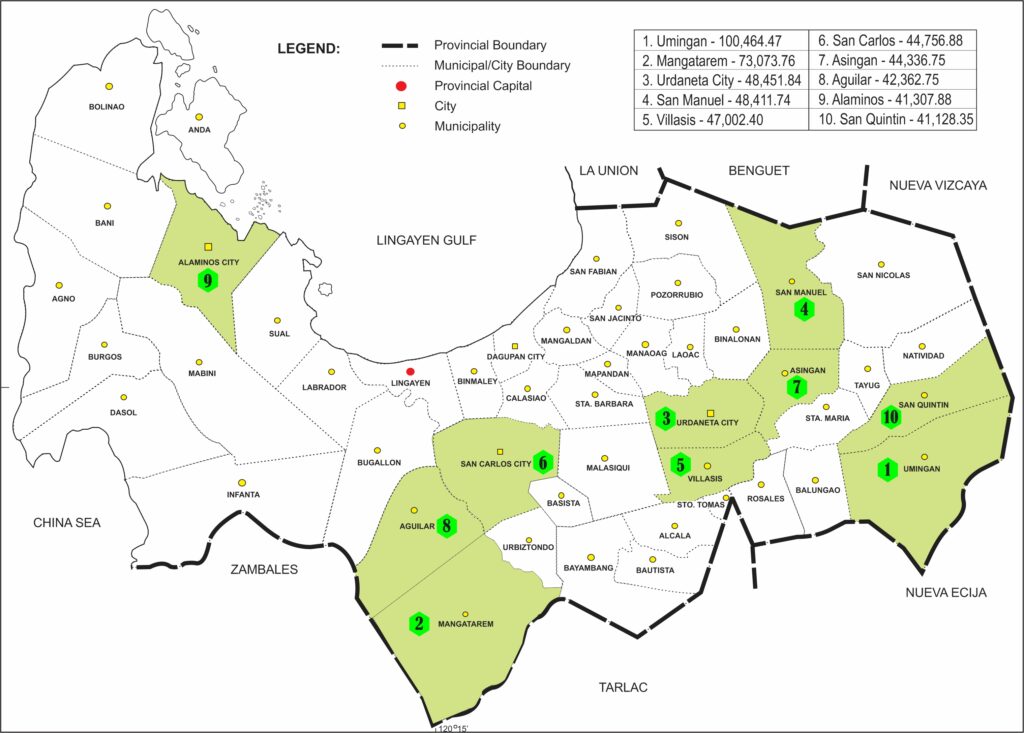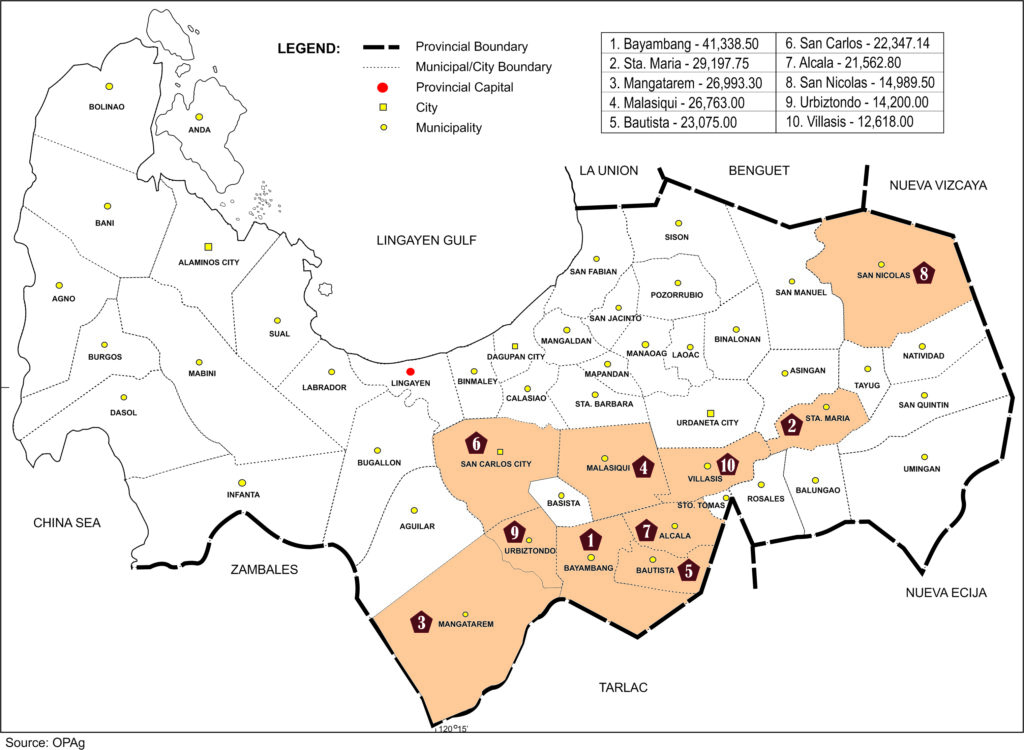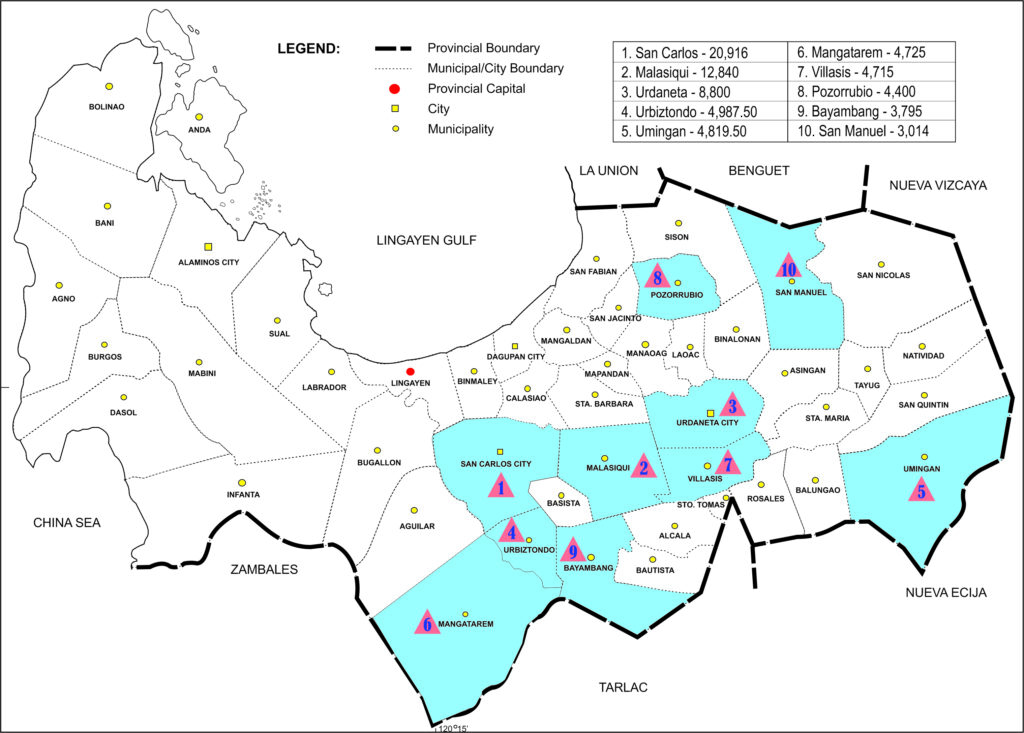Agricultural Crops
Cereal production decreased by about 14.8% from 1,529,310.73 MT in 2018 to 1,302,736.85 MT in 2019. Bulk of the cereal production was made up of palay which accounted for 1,247,582.44 MT, higher by about 9% compared to previous year’s figure of 1,144,814.29 MT. Consequently, with a milled rice production of 746,054.3 MT, the province posted a rice sufficiency level of 200.55% for the year in review. Corn production has decreased by about 2% from last year’s 384,496.44 MT to 377,101.77.
The top ten (10) palay and corn producing municipalities/cities are mostly situated in the central and eastern part of the province.
TOP TEN (10) CITY/MUNICIPALITY IN PALAY PRODUCTION
(in metric tons)

TOP TEN (10) CITY/MUNICIPALITY IN CORN PRODUCTION
(in metric tons)

The fruit production on banana, mango, papaya and watermelon has an increase of 16% from the previous production of 112,873.95 MT (2018) to 131,047.15 MT. Mango remained to be the biggest contributor in the total fruit production in the province contributing almost 83%.
Top ten (10) mango producing municipalities/cities are found in the central and eastern part of Pangasinan.

For legumes (mung bean and peanut), the total production is 4,138.67 MT, a decreased of 23.6% was noted from last year’s figure of 5,416.72 MT. Root crops’ production is 65,659.78 MT. On vegetable production, some 168,999.76 MT were harvested, an increase of almost 12% compared to last year’s production of 151,082.78 MT. The increase was due to the significant growth in the production of Okra and the added production of Sitao.
Tobacco production slightly increased by 13.1% from last year’s 4,506.19 MT to 5,097.20 MT. Meanwhile, on coconut production, it is still pegged at 23,388,375/year (2018 data), with District I having the bulk of production with 13,747,000 or almost 59% of the total production/year
The province has a total number of 174,083 farmers cultivating an area of 183,596.87 hectares. There are 58 agrarian reform communities in the province covering 329 barangays with 35,541 Agrarian Reform Beneficiaries, cultivating a total agricultural area of 95,943.8354 hectares.
Livestock and Poultry
This year’s inventory of livestock and poultry population has increased by 42.83% from 3,726,987 heads (CY 2018) to 5,323,155 heads (CY 2019), with poultry having the largest number of 4,750,875 heads or about 89% of the total livestock/poultry population. Poultry population has increased by more than 61% compared to last year’s population of 2,942,950. However, livestock population has decreased from the previous year’s figure of 784,037 to 572,280 heads or about 27% of the total livestock population.
Fishery
Total fishery production this year has increased by 4.68% from 126,766.454 MT in 2018 to 132,704.32 MT, posting a high sufficiency level of 119% which implies that the fishery production have surpassed the total fish demand of the province.
Forestry
To ensure forest protection and uplift the socio-economic condition of upland farmers, activities such as reforestation, agro forestry, fuel wood/fruit tress plantation are being undertaken by about 1,701 beneficiaries under the Integrated Social Forestry (ISF) occupying an area of 2,911.67 hectares in the 38 barangays of Western and Eastern Pangasinan.
Agricultural Support Facilities
There are 20 ice plants and cold storage operating in the province which primarily caters to the preservation needs of fish traders or viajeros.
In 2018, support facilities for various crops include 333 rice mills, 351 warehouses and 3 mechanical dryers. Majority of these post-harvest facilities are located in District I.
In addition, there are 1,345 grains establishment, about 40% of which are retailers, 44% are on retail/wholesale and, almost 16% fall under wholesale classification.
Trade & Industry
The province has a total number of 14,931 micro, small and medium enterprises (MSMEs), which have increased by more than 25% from last year’s 11,930. The total number consists mostly of micro enterprises whose income is Php 3M and below.
The average consumer price index (CPI) for all income household for all items has increased from CY 2018 figure of 117.90 to this year’s 121.10. The purchasing power of peso has decreased from last year’s 0.85 to 0.83. Likewise, the province’s inflation rate has decreased from 6.90 (2018) to this year’s 2.7.
There are 14,931 registered establishments, an increase of about 25% from last year’s 11,930 establishments in Pangasinan, with a total investment amounting to Php 2,732,459,768.00.
Dominating the Business Name Registration are the Trading and Personal Services sectors with about 48.57% and 42.46% of the total number of registered establishments, respectively. On the other hand, Industrial Services sector has the least with only 1.18% of the total number of establishments.
From the registered business establishments, some 30,118 persons were employed, showing a significant increase of almost 93% from last year’s figure of 15,630, majority of which are employed under personal services sector (46.24%), followed by trading services (41.30%), manufacturing (7.57%), agri-business (2.82%) and, industrial services (2.07%).
Agriculture, Forestry and Fishing, and Manufacturing Industry Sectors are considered as the leading industries in the province having a value of exports amounting to US$ 0.301M.
The province has a total of 41 registered Call Centers/Business Process Outsourcing or BPO.
For industries with best potentials, mango industry is seen to be suitable in Central Pangasinan, salt industry is best in western part and industries for vegetables are best preferred in the eastern part.
Financial Institutions
There are 858 Financial Institutions operating in the province, under the Bangko Sentral ng Pilipinas. Pawnshops have the most number with 362 (42%), followed by various types of bank with 335 (39%), Remittance and Transfer Companies/Money Changers/Foreign Exchange Dealers with 148 (17%), and non-Banking institutions with 13 (2%). Also, some 379 automated teller machines (ATM) are strategically installed within the province
Tourism
Based on the Provincial Tourism, Culture and Arts Office, the survey of tourist arrivals based on accommodation establishments registered a total of 804,433 tourists, both domestic and foreign. On the other hand, the survey of day tourist based on tourist destinations, accounted for some 10,075,891 domestic and foreign tourists, which are dominated by the Manaoag Pilgrims, with more than 81% of the total number of day tourist.
There are a total of 510 Accommodation Establishment (AE’s) in the province which employs about 3,079 employees. The establishments have a total number of 5,700 rooms which can accommodate a maximum of 26,866 persons per day. District I has the highest with 279 AE’s, followed by District IV with 69 AEs.
A total of 48 shopping malls are strategically located in the province, which provides employment opportunities to Pangasinenses and contributes to the economic growth of the province.


